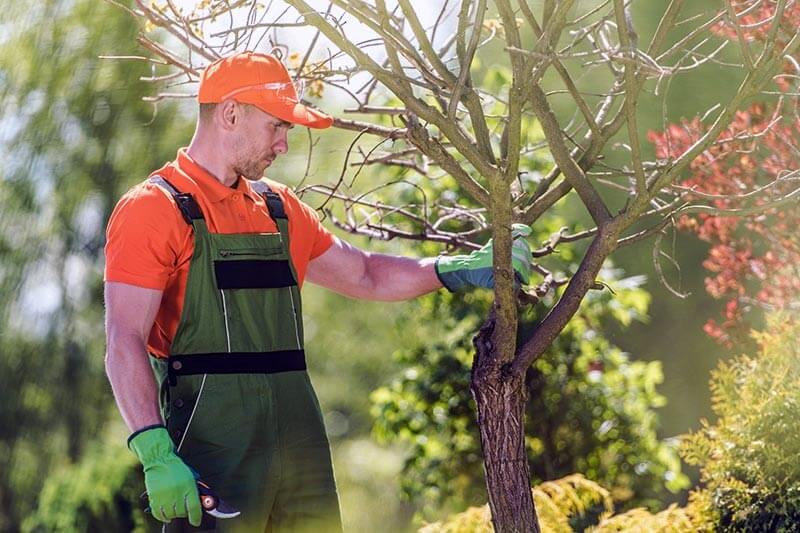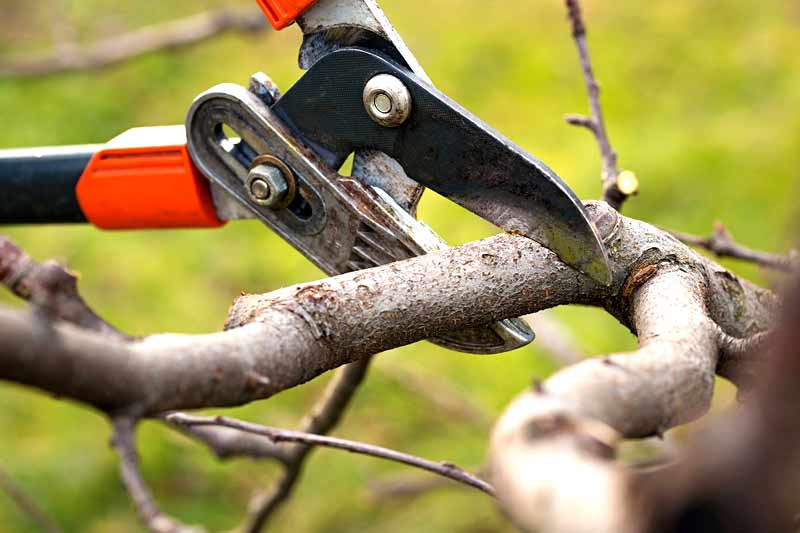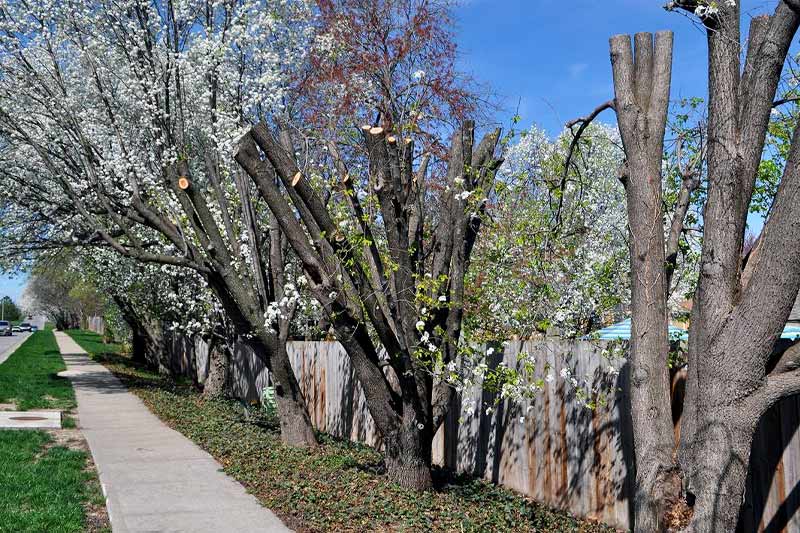Over-pruning a tree can be as bad or worse than not pruning at all. Pruning helps to regulate the size and shape of a tree, promotes growth, and improves the quality of flowers or fruit. However, there is a limit to how much you can prune and doing it right requires proper training and expertise.
If you over prune a tree, it will start to show signs of poor health. It may start developing water spouts, prolific epicormic shoots (suckers) on the trunk and branches, brown leaves, weak branches, and a dying trunk. It can even die.
Here is everything that you need to know about tree pruning, and what happens when you over prune.
Yes, you can prune too much of a tree.
Over-pruning is a detrimental practice that can severely damage a tree. When too much of a tree is pruned at once, it can strip it of a significant portion of its photosynthesizing leaves, thereby stressing and weakening the tree. This leaves it more susceptible to disease and pest infestations.
Proper pruning practices are essential to ensure the health, longevity, and safety of trees in our landscapes. As a general rule, you shouldn’t prune more than a third of the canopy of your tree. Any more and you will be over-pruning it.

What Happens if You Over Prune a tree?
Over pruning can damage a tree in several ways. The following is what will happen if you over prune a tree.
Reduced limb strength
Trees need even quantities of foliage distribution and outward growth to balance stress load rather than concentrate it at particular points. When too much lateral growth or foliage is removed, the tree undergoes more stress, leading to limb breakage or weak branches that struggle to endure winds or ice loads. Most times, the plant may exhaust itself, trying to replenish its canopy.
Sunburn
When a tree’s protective canopy is severely reduced, the tree can get sunscald from too much exposure to the sun. Sunburn can affect any part of the tree, especially the bark. If the damage reaches the tree’s inner tissue, fungi, bacteria, insects, and other organisms can attack the tree and cause irreversible damage.
Staunted growth
Over-pruned trees may experience stunted growth because they are expending energy to quickly produce new shoots to compensate for the loss. These rapidly growing shoots, sometimes called “water sprouts,” are typically weak and grow vertically from the remaining branches.
It will become infested by pests
Over pruning creates a lot of open wounds. These wounds often serve as pest magnets. This is because wounded areas are devoid of any of the tree’s protective cover. Therefore, it shouldn’t be surprising for an over-trimmed tree to become infested.
It will become susceptible to tree infections and diseases
Over pruning is stressful on a tree. It makes a tree less capable of defending against tree infections and diseases. As a result, the tree becomes vulnerable to attacks. And so an over pruned tree is likely to show signs of sickness.
Decreased photosynthesis
Trees produce food by photosynthesis through the leaves. When excess foliage is removed, it significantly reduces the tree’s ability to produce food for itself. Over-pruning decreases the food’s storage, and you must ensure the tree has enough foliage to stay healthy and strong.
Can You Kill a Tree From Over Pruning
Yes, over-pruning can severely stress a tree and, in extreme cases, lead to its decline or even death. Removing too much of a tree’s canopy reduces its photosynthetic capacity, depriving the tree of the energy it needs to grow and thrive.
Over-pruning can also make a tree more susceptible to pests and diseases, weaken its structure, and result in long-term health issues.
While a single instance of over-pruning might not kill a healthy tree immediately, repeated improper pruning can significantly reduce its lifespan and vitality.
What Should You do if Your Tree is Over Pruned?
Over pruning is bad for a tree. But this doesn’t mean it is a mistake that is not fixable.
If you have an over-pruned tree, here is what you should do.
Seek an expert's advice
The first step is to consult a tree expert. The consultation’s main goal is to find out whether it is worth rescuing your tree.
Some trees can easily survive extreme pruning. Others can’t. And the chances of survivability also depend on the degree of over-pruning.
These are things that an ISA-certified arborist will be able to know. And so, based on your tree’s condition, they can tell you whether a health restoration project is worth the time and effort.
Water the tree
As the tree is trying all it can to recover from the trauma of over-pruning, it will need all the help that it can get. And since moisture is essential to the recovery and healing process, watering it will really help to improve its odds of surviving.
Provide it with sufficient nutrients through fertilization
Nutrients provide the building blocks for new tissue. They also help to strengthen a tree’s immune system.
Therefore, providing it with all the nutrients that it needs will not only help in its defense against pests and infections, but also speed up the recovery process.
Thin the tree where necessary
As the tree regains its strength, you will eventually have to thin it out. This is because while the water shoots may have been essential to the tree’s initial survival, leaving them in place will lead to an uneven and weak canopy.
Thinning allows you to get rid of these weak growths. And with time, it will help to establish a strong canopy.
Given that over-pruning is traumatic to a tree, the steps that you take to help it recover from this trauma will play a significant role in determining whether it will survive the experience. And taking the above steps will go a long way in improving the chances of survival.
What Other Pruning Mistakes Should you Avoid?
When pruning, there are things that you should avoid doing if you want to ensure that you don’t harm your tree.

You should avoid pruning at the wrong time
Pruning stresses your tree. Therefore, you should time your pruning so that the tree incurs the least damage. You should also ensure that you give the tree enough time to recover.
The best time to prune most trees is during the dormant season, typically in late winter to early spring, just before new growth starts. This timing reduces the risk of disease transmission and allows wounds to heal quickly with the onset of the growing season.
However, spring-flowering trees should be pruned immediately after they bloom. Always avoid pruning in the fall, and for specific tree species or concerns, consult with a local arborist.
Using dirty pruning equipment
When you trim a tree’s branches off, you are literally creating open wounds. Therefore, if you are using dirty equipment to do this, the chances of these wounds developing an infection will be high.
Pruning during the warmer months
Some areas are prone to diseases like Dutch elm and oak wilt. These diseases can easily spread from tree to tree, especially during the warmer months.
Therefore, if you live in such areas, it will be a bad idea to trim your tree in the warmer months as it will make them more susceptible to disease attacks.
Making bad cuts
Bad pruning cuts create unnecessary wounds. They expose the tree to unnecessary injury. And they also increase the likelihood of infections and pest attacks.
Therefore, when pruning your tree, you should avoid making:
- stub cuts
- heading cuts, or
- flush cuts
FAQ's
You can cut off up to 33% of a tree’s canopy without killing it.
Trim any more of the tree’s foliage past this point, and you risk inflicting damage the tree may find hard to recover from. As a result, it is always advisable to only trim about 1/4th of a tree’s canopy.
Topping has a detrimental effect on a tree’s wellbeing.
Here are the main effects of tree topping.

- Water sprouts development
This is because topping eliminates a large chunk of the food-producing part of the tree. To compensate, the tree will develop weak shoots that are referred to as water sprouts.
- Increased risk of damage
Since the new branches and leaves are being generated while the tree is under stress, they are generally weak. This makes it easy for these branches and leaves to break during extreme weather.
- Loss of aesthetic appeal
Topping a tree leaves behind an ugly shadow of the tree’s initial appeal.
It leads to the development of random patches of weak branches, stems, and leaves. It also robs it of a majestic canopy. All of these things add up to a less appealing sight.
- Increased incidences of disease and pest attacks
Topping creates significant tree wounds. These wounds are attractive to pests. They are also susceptible to rotting. And they can also serve as entry points for diseases.
Therefore, after topping your tree, you shouldn’t be surprised if it becomes infested with pests or if it becomes disease-ridden.
A tree can continue to grow if you cut its top off. However, whether it can survive such a traumatic event largely depends on the species of the tree and the tree care steps that you take right after.
What this means is that a tree can easily die from cutting off its top. This is one of the main reasons why this is a practice that is generally discouraged.
The easiest way to avoid trimming too much of a tree, and the surest way to guarantee that a harmed tree will recover, is to rely on the expertise, knowledge, and experience of tree experts.
GoTreeQuotes.com offers a free service that quickly matches you with the top-voted local experts in your area.
Using the website, you can get 3 estimates fast by real certified experts in your area in just 2 minutes. Here is how it works.
- You scroll to the top of the page and enter your Zip code.
- Answer questions about your tree care needs
- Your details will be forwarded to three local experts.
- You will then receive a price estimate for the job and some friendly advice.
IMPORTANT: There is no obligation to hire. This is a free tool and service to be used at your pleasure.











